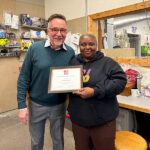Reaching Out: Art as Therapy.
- attended Milton High School, Milton, MA/ Riverside University High School, Milwaukee, WI
- graduated 2004 BFA Illustration / 2006 MPS Pratt Institute
- currently a Senior Rehabilitation Counselor at Lincoln Medical + Mental Health Center, South Bronx, NY

Briana MacWilliam
“At the end of four years, all the majors seemed to fuse into one, and they were all so integrated into each other it was hard to know where one focus began and another ended. Designers influenced painters, printmakers influenced design, drawing influenced sculpture, sculpture influenced interior architecture + design, and so on and so forth. Do what you love.”
Q. What did you want to be when you grew up?
A. I always wanted to be an artist. Ever since nursery school I remember wanting to be that. An artist or a carpenter, or a ballerina, which ever came more naturally.
Q. What was your first memorable experience with art and design?
A. My most memorable experience was when I was in Pre-Kindergarten and I was attempting to represent Santa Claus’ beard with a yellow marker. The teacher interrupted me and showed me that simply drawing a black outline, instead of trying to create the illusion of white with yellow, was more effective. I have never looked back.

Q. How did your MIAD education affect where you are today?
A. MIAD brought me to Ireland my junior year on an exchange, to the Burren College of Art, where I feel I had a kind of spiritual awakening of sorts. It lead me in the direction of Art Therapy, which was the area of study for my Master’s Degree. MIAD also challenged me to think differently about the ways that I viewed things, really pushed the creative parts of my brain that a public education tends to ignore.
Q. What’s the one thing you would tell a high school student who is considering attending MIAD now that you’ve experienced life after graduation?
A. Don’t worry about being practical. Don’t be a designer because you think it will make you more money. But don’t feel self-conscious about being a designer because you aren’t ‘artsy’ enough.
At the end of four years, all the majors seemed to fuse into one, and they were all so integrated into each other it was hard to know where one focus began and another ended. Designers influenced painters, printmakers influenced design, drawing influenced sculpture, sculpture influenced interior architecture + design, and so on and so forth. Do what you love. The loans will take care of themselves. It’s just a bill you pay like the phone or electric.
Q. If you had to sum up your job in a single sentence, what would it be?
A. Before I graduated [from Pratt] I was already hired at Lincoln Medical and Mental Health Center in South Bronx, NY, as the supervising activities therapist for the adult inpatient psychiatric unit; my official title being “Senior Rehabilitation Counselor.”
Q. What are your goals for the future, in art/design and in life?
A. Currently, I am earning hours toward my license as a Creative Arts Therapist, and my ATR (Art Therapy Registration) with the American Art Therapy Association. My goals are to complete the license, work for a few years with various populations, gain some more experience and then go back to school for a PhD in something related. I would like to eventually have my own practice and open a kind of community center for the arts and art therapy. Oh, and learn spanish.
Q. Are there any specific parts of your resume that you’d like to share?
A. I graduated with Honors from Pratt’s program in Creative Arts Therapy in 2006, with a Master’s in Professional Studies and Creativity Development. My thesis was a research project, which was a phenomenological study on the use of visual journaling as a therapeutic intervention for men in the military. Q. Please define how you saw your major while in school, and how that definition has changed over the years.
A. In school I though illustration was more practical, and suited my process of working and narrative style. After I went to Ireland, however, I realized that the commercial aspect of it was not the direction I wanted to go in. The art became more about process than product, and so I went to graduate school to further investigate my inclinations.







